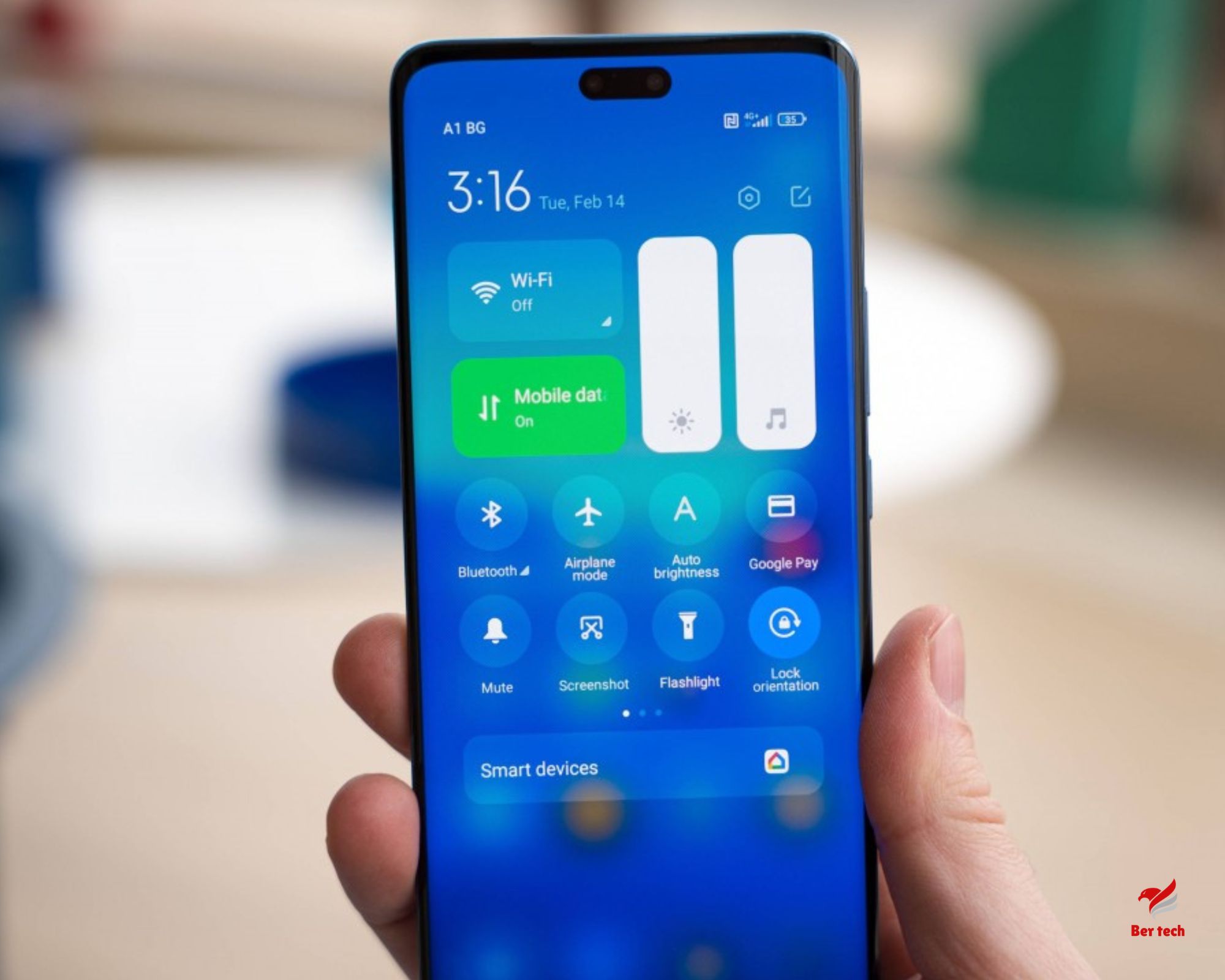Introduction and specs:
The display is essentially the same as last year's, except that it's curved this time around, and the diagonal is still 6.55", making it a somewhat compact mid-range solution. One of the most notable changes is the new chipset, though. This year, the Lite will be powered by the brand new Snapdragon 7 Gen 1 SoC, promising improved efficiency and performance compared to the older Snapdragon 700 series.
Design and ergonomics
MIUI 14 based on Android 12
To our surprise, the Xiaomi 13 Lite runs on Android 12, not 13, but MIUI is the latest version 14. This means that not all MIUI features the company showcased during the Chinese Xiaomi 13 series launch event. That puts the Xiaomi 13 Lite at a slight disadvantage because we were looking forward to seeing MIUI 14 in its full glory. It promises mostly under-the-hood changes and optimizations but there are some new features too.
Supposedly, MIUi 14 is built almost from scratch as engineers have reworked the core architecture of the MIUI ROM down to Android's Kernel level. That includes new CPU, GPU, and memory scheduling, smaller firmware size, and decreased memory usage overall. As a result, Xiaomi claims a 60% smoother experience and considerably optimized processes. Automatic compression for apps that are not actively used is also on the menu. Unfortunately, though, those are features that we can reliably test and confirm that are adopted in Xiaomi 13 Lite. They may remain exclusive to Android 13-powered handsets.
Feature-wise, we found some of the advertised functionalities of MIUI 14. The new enlarged folders are here and the Gallery app gains native text recognition in addition to the Google Lens integration. New large folders on the home screen are also available.
Other features such as a Smart Devices toggle for easier management of Xiaomi smart devices, new widgets, and a toggle for turning off permanent notifications are nowhere to be found. We are also still waiting for the notification history option, which is an Android-intrinsic feature.
The rest is business as usual and we will try to focus on features that are somewhat unique to MIUI or are standout functionalities in a way.
The split between a notification shade and Control Center is enabled by default and that's probably a good thing. We found it to be quite convenient, and it's a way to educate users about MIUI's unique approach to the UI. And in case you are not a fan, you can always revert back to the standard notification shade with quick toggles in one place.


Control center and notification panel
The home screen, recent apps, and general settings remain unchanged. The app drawer is also enabled by default and we like that Xiaomi has placed the search bar at the bottom of the screen for easier reach. There are custom and preset app categories for faster navigation.






Home screen, recent apps, settings menu, app drawer
Unlike the standard recent apps menu, MIUI's one lists the apps vertically (you can switch to the standard horizontal alignment) and provides several useful shortcuts. That's where you can open up apps in floating windows. However, you can keep up to two apps open at a time. In case you want a faster shortcut to apps that support free-form windows, just enable the Sidebar.
Floating windows
The sidebar becomes Video Toolbox in video player apps such as YouTube. It essentially contains the whole Sidebar functionality, but besides options for floating windows, it contains shortcuts for Screenshots, Record screens, Cast, and Play videos with the screen off, which works on YouTube, no Premium subscription is needed. But, as we mentioned, you need to whitelist the apps in advance where you want the feature enabled.
Video toolbox
Themes have always been a huge part of MIUI, and they are available on MIUI 14, too. You can download new ones from the Themes store, and they can change wallpapers, ringtones, system icons, and even the always-on display style. Super Wallpapers are available too.





Themes and other customizations
Of course, Always-on display customizations are also available in addition to the presets. The Notification effect lights up the edges of the display when new notifications come in, but there's little in the way of customization other than a couple of different colors and a 'Starlight' option. This effect can work with or without the AOD.
Always-on display
Moving on to privacy and security, MIUI has come with a pre-installed system Security app. Aside from the additional malware protection layer it provides, the app holds many of the app settings and privacy features in one place. It can manage your blacklist, manage or restrict your data usage, configure battery behavior, and free up some RAM. It can also manage the permissions of your installed apps, define the battery behavior of selected apps, and apply restrictions only to certain apps.
Speaking of security, the fingerprint reader seems to be fast and reliable enough. We had no issues even when outside on a bright sunny day. There's an extended functionality of the fingerprint reader, allowing you to open up an app or initiate action as soon as you unlock the device - just keep your finger on the scanner when it unlocks. It's a lot like OnePlus' OxygenOS/Oppo's ColorOS/Realme's Realme UI feature, but this one doesn't allow customization. We didn't find a way to add shortcut apps, so you are stuck with the Search and QR Code scanner.



Fingerprint reader and quick shortcuts
All in all, MIUI 14 changed little over the 13th iteration in terms of overall user experience and that's not bad. it's just as snappy and customizable as ever. Xiaomi has paid special attention to the haptics on this unit, and we found the motor to be crisp, strong, accurate, and responsive. It reacts to many actions across the system and when navigating. There's even a haptic feedback intensity if you find it obtrusive or not strong enough.
Benchmark performance
The Snapdragon 7 Gen 1 chipset has been announced almost a year ago but hasn't been widely adopted since. The first devices available to Western markets running the SoC are from Xiaomi's camp and in this case, the Xiaomi 13 Lite. The new chipset is based on the 4nm manufacturing process and includes Qualcomm's dedicated AI Engine. The CPU package contains an octa-core CPU with 1x2.4 GHz Cortex-A710, 3x2.36 GHz Cortex-A710, and 4x1.8 GHz Cortex-A510 cores while the GPU is the Adreno 644. The latter is supposed to be 20% faster than the older Snapdragon 778G while AI-related tasks are said to be 30% faster. In addition, the Adreno Frame Motion Engine claims to boost framerates two-fold while maintaining the same power consumption as the Snapdragon 778G. Although, that's hardly an issue for now given that most games are locked at 60 fps years after the mass adoption of HRR screens.
The ISP is more powerful now handling up to 200MP camera sensors and it also supports 4K HDR video recording as well as 10-bit HEIC photos.
Our unit, in particular, is paired with 8GB of RAM and 256GB of internal storage.
The usual triple-camera setup on the back, unusual dual setup on the front
The main camera uses a 50MP Sony IMX766 sensor, which is a common occurrence in the price range. It's a fairly big one, measuring 1/1.56", and offers big 1.0µm pixels. The shooter is paired with a wide f/1.8 aperture. We intend to see whether the 50MP sensor in this year's Xiaomi 13 Lite really is a downgrade compared to last year's 108MP Samsung ISOCELL HM2, 1/1.52", 0.7µm sensor.
The ultrawide camera remains unchanged from last year - 8MP, 1/4.0", 1.12µmp sensor paired with an f/2.2 lens covering a 120-degree field of view.
The third camera is a dedicated macro shooter with a tiny 2MP 1/5.0" sensor and there's no autofocus. The aperture is f/2.4.
On the front, we have a dual-camera setup with 32MP f/2.4, 1/2.74", 0.8µm ultrawide main selfie camera with a 100-degree field of view. The second one is an 8MP depth sensor for better bokeh shots.
Camera menus
The camera app is a rather straightforward implementation, though it does have its quirks. First, the basic operation for changing modes works with sideswipes (on the black bezel!), and you can also tap on the modes you can see to switch to those directly. Up and down swipes don't work for switching between the front and rear cameras; only the toggle next to the shutter release does that.
You can add, remove, and rearrange modes in the main Rolodex by going to the More tab and navigating to the edit button, and you can access that from the settings menu as well. The unused modes will still be in that More tab, but you can switch to a (less intuitive) pull-out pane that's summoned from a line next to the shutter release.
Camera modes
The hamburger menu at the far end is where you'll find additional options, including the Macro mode, which apparently still doesn't deserve a place in the main carousel with modes. Next to that hamburger menu, you have a flash mode switch, an HDR switch, an AI toggle, and a shortcut to Google Lens.
At the near end, you have the camera zoom switch that operates in one of two fashions. The first one is simply tapping on one of the three dots that represent the ultra-wide, primary, and 2x digital options. Or you can tap on the active magnification and slide sideways to reveal even more zoom levels - 2x and 10x, plus a slider for intermediate magnifications. Also around is a magic wand with beauty effects and filters.
Camera settings
There's a nicely capable Pro mode, where you can tweak the shooting parameters yourself. You can use the primary and the ultrawide cameras here. You get to pick one of 4 white balance presets or dial in the light temperature with a slider, there's a manual focusing slider, and shutter speed (1/4000s to 30s/0.8s for main/ultrawide) and ISO control with the range depending on which camera you're using. A tiny live histogram is available, and a toggle for zebras can be found next to the hamburger menu.
As expected, there's a host of extra modes, including Long Exposure with its own set of different presets - moving crowd, neon trails, oil painting, light painting, starry sky, and star trails.
Night mode is available on the main and ultrawide cameras. There is also Auto Night mode enabled by default in settings.
Daylight photos
Main camera
The Xiaomi 13 Lite takes nice outdoor photos during the day. In fact, one could argue that the 13 Lite takes slightly sharper photos than its predecessor, despite having a lower-resolution camera. Dynamic range is also excellent, detail is enough and noise can only be seen under close inspection in the shadows. That's when sharpness drops dramatically, which is one of the few complaints we have.
Daylight main camera samples
Interestingly enough, the photos have a more conservative color reproduction than we are used to seeing from Xiaomi, especially mid-range ones. Contrast is also noticeably lower than usual and overall exposure tends to be a hair brighter. It's not inherently bad, but it's a soft departure from Xiaomi's typical look.
The indoor shots leave a little bit more to be desired if the lighting isn't ideal. Photos are considerably softer and introduce a little bit of grain in the shadows. Nothing too major, though.
All in all, the daylight shots are par for the course, falling behind only the Google Pixel 6a, which is a notable cameraphone in this price range.
2x zoom
Understandably, the 2x zoom mode produces less-than-ideal photos as it's a simple crop from the main camera and upscaled back to 12.5MP. They are noticeably softer with more visible noise in the shadows as well as a bit of loss in detail. And while they are just about what you'd expect from such a phone in this price bracket, last year's Xiaomi 12 Lite offered slightly sharper, clearer, and more appealing 2x zoom photos. Perhaps that's where the older 108MP sensor shines.
Otherwise, the rendition is pretty much identical to the standard 1x zoom mode.
Ultrawide camera
The Xiaomi 13 Lite takes somewhat better ultrawide shots compared to your average midrange using the same 8MP sensor. However, photos are generally softer and less detailed. You can even find some small color fringing here and there in addition to the increased noise in poorly-lit environments. The Samsung Galaxy A53 and the Google Pixel 6a are one of the few that stand out in the crowd as they use far superior ultrawide sensors to the 8MP one here.
Contrast and colors are nice, though, and the dynamic range is one of the best we've seen from a phone with that sensor. This was the case with the 12 Lite as well.
Macro camera
The macro camera, as usual, isn't very impressive and produces mediocre photos with unsatisfactory detail, which is normal given the tiny 2MP sensor. You also have to make sure you take these shots in the perfect lighting conditions as quality deteriorates fast in sub-optimal conditions.
Macro camera samples
Low-light samples
Main camera
As soon as the light drops, the software automatically shoots in the dedicated Night mode. You can disable that in the camera settings if you wish to take standard Photo stills at night. However, we wouldn't recommend that and it's better to stick with the Night mode, and here's why.
The low-light photos are pretty good for the price range. They are generally well-exposed with plenty of detail in the shadows, albeit a bit noisy in these areas, but that's to be expected, and with excellent highlight handling. There's a noticeable improvement in dynamic range compared to last year's Xiaomi 12 Lite. Sharpness tends to go down only in the shadows but photos are looking natural without oversharing halos. We have a few small remarks, though - contrast and colors need a little boost as colors often look washed out, while some light sources look artificially rendered. Notice the street lights in particular.
The dedicated Night mode fixes most of these issues. Noise is washed away giving the images a considerably cleaner look, colors are more pleasant and closer to real-life, dynamic range is even wider with excellent handling of street lights and neon signs. We've noticed that there's some artificial sharpness at play here, but it's just the right amount so photos don't look artificial or computer-generated.

Night mode main camera samples
2x zoom
Unfortunately, with or without Night mode, the 2x zoom mode doesn't produce acceptable results. Photos without Night mode are extremely soft, have zero detail and noise is all around. The Night mode clears up the noise, adds some contrast and color, and sharpens things a little but the samples we took are still far from ideal.

Low-light 2x zoom: Normal • Night mode
Ultrawide camera
The ultrawide camera struggles at night, no matter the mode. Images are just too soft, with washed-out colors and noisy to be usable, even for social media purposes. It's a tiny 1/4.0" sensor, after all, so low-light scenarios aren't its strongest suit.
Low-light ultrawide: Normal • Night mode
Here's how the primary camera on the Xiaomi 13 Lite stacks against the rest of the competition in the controlled environment of our Photo Compare Tool.



Xiaomi 13 Lite vs. Realme GT2 Pro and the Xiaomi 12T in our Photo Compare tool
Portraits
The portraits leave a bit more to be desired in terms of overall sharpness and detail. Last year's 12 Lite produces better portraits overall, regardless of the lighting conditions. The 13 Lite seems to struggle with not-so-bright environments and as a result, sharpness and detail get the biggest hit. Contrast and dynamic range and color reproduction are nice, though. We noticed that the subject's skin looks somewhat natural while the colors around him are a bit on the juicy side, which is good.
Portraits
Edge detection is okay as long as you aren't pixel-peeping around the subject's hair, especially if it's messy.
Selfies
Selfies are definitely underwhelming. There's no pixel binning and the main sensor takes full-resolution 32MP photos. The viewfinder offers three separate toggles - normal (1x), wide (0.8x), and ultrawide (0.6x). As you've probably guessed, all field-of-view options are crops from the main ultrawide camera with the 0.8x and 1x modes being upscaled back to 32MP after the crop.
Selfies: 1x • 0.8x • 0.6x
All variants are rather soft, lack a sufficient amount of detail, and are a bit grainy. The good news is that the selfie camera takes shots with consistent quality across different lighting scenarios. The HDR algorithm is competent enough, the colors are nice and the contrast is nice. Still, the selfies are definitely a downgrade over the previous generation which also had AF on its selfie.
The portrait mode seems to be just a tad better on the 13 Lite compared to your average midrange due to the extra depth sensor. Still, the difference isn't striking and you can see some of the edges around the subject being smoothed out if you look close enough. All in all, we are not convinced the extra depth sensor is worth taking the extra space on the front given the little value it adds
Selfies: Normal • Portrait
Video recording
The video recording capabilities are business as usual - the main camera can go up to 2160p@60fps while the ultrawide one is limited to 1080p@30fps. You can take 2x zoom videos at 4K resolution as well, which is a simple crop from the main unit. As far as stabilization goes, the standard 2160p@30fps video is stabilized but a more advanced action cam-like stabilization is also available, which limits the video's resolution to 1080p. Xiaomi calls it Steady mode.
Just like last year, the 4K footage looks great. There is a noticeable change in the processing - colors are more conservative and true to life. We saw a similar overarching color processing in the stills. Aside from the bit brighter-than-usual exposure, the video has a good amount of detail, it's sharp, has a wide dynamic range, and has excellent contrast. The Xiaomi 13 Lite leaves little to complain about.
Competition
The Xiaomi 13 Lite now competes around the €500 price point and although it has a lot to bring to the table, it may struggle to compete with the pricier handsets. The display is impeccable, flagship-grade, even with high peak brightness, 120Hz refresh rate, and exceptional color accuracy in addition to the HDR10+ and Dolby Vision support. The new Snapdragon 7 Gen 1, although marginally faster than the older Snapdragon 778G, is built on a more efficient manufacturing process, offers some extra features, and handles graphically-intensive tasks better. The 13 Lite also has above-average ultrawide camera performance and great main camera quality day and night. The dual selfie camera setup is a nice bonus, although we do miss the AF feature from the previous generation and overall quality.
Design-wise, we think that Xiaomi couldn't have done better. The 13 Lite is every bit as sleek, premium to the touch, and comfortable to hold as the true flagships in the series.
But since the Lite is released in early 2023, most of its competitors are last year's models and as such, their prices have fallen, leaving the 13 Lite in a bit of a predicament. Most competitors are cheaper. The near €100 price hike coming from 12 Lite is a bit hard to justify.
Let's start with some considerably cheaper options around the €300-400 price range. We have the Realme GT2, which is a proper flagship killer from last year, the Pixel 6a with clean Android, again with flagship SoC on board, the OnePlus Nord 2T, which is a nice, affordable all-rounder and, of course, last year's Xiaomi 12 Lite. Arguably, these phones offer the same user experience overall and sometimes better performance and battery life (Realme GT2) or better camera experience (Google Pixel 6a).
Google Pixel 6a • OnePlus Nord 2T • Realme GT2 • Xiaomi 12 Lite
In the €400-500 bracket, however, the Xiaomi 13 Lite has no chance. In fact, some of the competition is homegrown. Both the Xiaomi 12T and the Poco F4 GT are viable options with better performance, faster charging, and, in the 12T's case, longer battery life too. Both devices are priced just under €400 and offer a better user experience or even better in some cases.



Xiaomi 12T • Xiaomi Poco F4 GT • Realme GT2 Pro
Another Realme phone worth mentioning is the Realme GT2 Pro, which is asking for around €20-30 more, but you get so much better value for money. Better display, longer battery life, a Snapdragon 8 Gen 1 chipset, faster charging, an excellent camera setup with a proper ultrawide camera, and a set of good-sounding stereo speakers. This is probably your best bet, even if it's a year-old device and a tad pricier.
We get that the Xiaomi 13 Lite should be compared to newer handsets in 2023, but most of the phone's direct competitors are not out yet, or they are still making their way to Western markets. This leaves the 13 Lite in a bit of a weird situation where it has to compete with considerably cheaper devices. But once Realme, Samsung, OnePlus, and other OEMs release their updated versions, the 13 Lite will have a much better chance of making a dent in this market segment. Alternatively, you can go for the older Xiaomi 12 Lite, as it offers a similar user experience at a lower price. As long as you can find it lying around on store shelves.
Verdict
Pricing aside, the Xiaomi 13 Lite is a great all-rounder with an impeccable display, fast charging, capable SoC, and good main camera performance. However, users will still have to choose the best value for money, and with the 13 Lite being considerably more expensive than its predecessor, the Lite isn't a viable mid-range solution anymore.
The 13 Lite leaves a bit more to be desired from the speaker setup (the stereo setup is replaced by mono), battery life is somewhat uninspiring, the 2x zoom was better on the last year's 108MP main camera and the Snapdragon 7 Gen 1 chipset fails to impress with performance in the context of a €500 phone. It's only marginally better than the Snapdragon 778G, too.
At the end of the day, the Xiaomi 13 Lite needs a price correction before it can be recommended, as it's hardly an upgrade over last year's generation while being significantly pricier. And even if months go by and the price settles, we believe that the 13 Lite will still be a bit too expensive for our taste. The launch price is way too high.







.jpg)
















.jpg)


















Enregistrer un commentaire